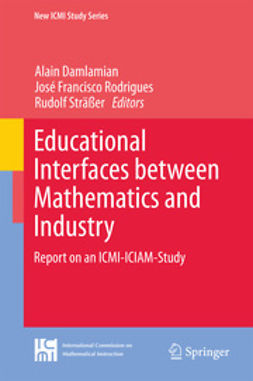Blum, Werner
Modelling and Applications in Mathematics Education
Part 1. Introduction
1. Introduction
Mogens Niss, Werner Blum, Peter Galbraith
Part 2. Plenaries
2. Less Chalk, Less Words, Less Symbols ... More Objects, More Context, More Actions
Claudi Alsina
3. What’s all the Fuss about Competencies?
Morten Blomhøj, Tomas Højgaard Jensen
4. A Theory of Mathematical Modelling in Technological Settings
Jere Confrey, Alan Maloney
5. What Knowledge Do Teachers Need for Teaching Mathematics Through Applications and Modelling?
Helen M. Doerr
6. Beyond the Low Hanging Fruit
Peter Galbraith
7. Modelling for Life: Mathematics and Children’s Experience
Brian Greer, Lieven Verschaffel, Swapna Mukhopadhyay
8. Modelling in Lower Secondary Mathematics Classroom — Problems and Opportunities
Gabriele Kaiser, Katja Maaß
9. Mathematical Modelling — a Conversation with Henry Pollak
Henry Pollak
Part 3. Issues in Applications and Modelling
10. Epistemology and Modelling — Overview
Jere Confrey
11. Modelling Body Motion: an Approach to Functions Using Measuring Instruments
Ferdinando Arzarello, Giovanni Pezzi, Ornella Robutti
12. Emergent Modelling as a Precursor to Mathematical Modelling
Koeno Gravemeijer
13. Proving and Modelling
Gila Hanna, Hans Niels Jahnke
14. A Developmental Approach for Supporting the Epistemology of Modeling
Richard Lehrer, Leona Schauble
15. What is Distinctive in (Our Views about) Models & Modelling Perspectives on Mathematics Problem Solving, Learning, and Teaching?
Richard Lesh, Caroline Yoon
16. Everyday Instruments: On the Use of Mathematics
Rudolf Strässer
17. Authenticity and Goals — Overview
Peter Galbraith
18. How to Replace Word Problems with Activities of Realistic Mathematical Modelling
Cinzia Bonotto
19. The Relevance of Modelling and Applications: Relevant to Whom and for What Purpose?
Eva Jablonka
20. Features and Impact of the Authenticity of Applied Mathematical School Tasks
Torulf Palm
21. Elementary Modelling in Mathematics Lessons: The Interplay Between “Real-World” Knowledge and “Mathematical Structures”
Ralph Schwarzkopf
22. Modelling Competencies — Overview
Brian Greer, Lieven Verschaffel
23. Levels of Modelling Competencies
Herbert Henning, Mike Keune
24. Modelling Both Complexity and Abstraction: A Paradox?
Mihaela Singer
25. Studying and Remedying Students’ Modelling Competencies: Routine Behaviour or Adaptive Expertise
Dirk Bock, Wim Dooren, Dirk Janssens
26. Assessing the “Phases” of Mathematical Modelling
Ken Houston
27. The Arithmetic Operations as Mathematical Models
Zalman Usiskin
28. Applications and Modelling for Mathematics — Overview
Eric Muller, Hugh Burkhardt
29. The Roles of Modelling in Learning Mathematics
Malcolm Swan, Ross Turner, Caroline Yoon, Eric Muller
30. Developing Mathematical Literacy
Lynn Arthur Steen, Ross Turner, Hugh Burkhardt
31. Classroom Activities and the Teacher
Soeren Antonius, Chris Haines, Tomas Højgaard Jensen, Mogens Niss, Hugh Burkhardt
32. Uses of Technologies in Learning Mathematics through Modelling
Daniel Pead, Bill Ralph, Eric Muller
33. Modelling Pedagogy — Overview
Hans-Wolfgang Henn
34. Mathematical Modelling in High School Mathematics: Teachers’ Thinking and Practice
Olive Chapman
35. Mathematical Modelling in Teacher Education — Necessity or Unnecessarily
Thomas Lingefjärd
36. Building Concepts and Conceptions in Technology-Based Open Learning Environments
Stephan Hußmann
37. Towards a Wider Implementation of Mathematical Modelling at Upper Secondary and Tertiary Levels
Djordje Kadijevich
38. How Might we Share Models Through Cooperative Mathematical Modelling? Focus on Situations Based on Individual Experiences
Akio Matsuzaki
39. Implementation and Practice — Overview
Thomas Lingefjärd
40. Some Conditions for Modelling to Exist in Mathematics Classrooms
Michèle Artaud
41. Picture (Im)Perfect Mathematics!
Wilfried Herget, Marlene Torres-Skoumal
42. Learning Mathematical Modelling — From the Perspective of Probability and Statistics Education
Ewa Lakoma
43. Considering Workplace Activity from a Mathematical Modelling Perspective
Geoff Wake
44. Assessment and Evaluation - Overview
Peter Galbraith
45. Modelling Based Project Examination
Søren Antonius
46. Mathematical Modelling and Applications: Ability and Competence Frameworks
Christopher Haines, Rosalind Crouch
47. “To Model, or to Let Them Model?” That is the Question!
Jerry Legé
48. Modelling and Applications in Pisa
Ross Turner
49. Assessment of Applied Mathematics and Modelling: Using a Laboratory-Like Environment
Pauline Vos
Part 4. Educational Levels
50. Modelling and Applications in Primary Education
Maria Salett Biembengut
51. Possibilities for, and Obstacles to Teaching Applications and Modelling in the Lower Secondary Levels
Toshikazu Ikeda
52. Upper Secondary Perspectives on Applications and Modelling
Gloria Stillman
53. Teaching Applications and Modelling at Tertiary Level
Claudi Alsina
54. Modelling in Teacher Education
Thomas Lingefjärd
Part 5. Cases in Applications and Modelling
55. Moving the Context of Modelling to the Forefront: Preservice Teachers’ Investigations of Equity in Testing
Katie Makar, Jere Confrey
56. Modelling in Ontario: Success in Moving Along the Continuum
Christine Suurtamm, Geoffrey Roulet
57. Implementation Case Study: Sustaining Curriculum Change
Gloria Stillman
58. Mathematical Modelling of Social Issues in School Mathematics in South Africa
Cyril Julie, Vimolan Mudaly
Part 6. Bibliography
59. Bibliography
Avainsanat: Education, Mathematics Education, Applications of Mathematics
- Tekijä(t)
- Blum, Werner
- Galbraith, Peter L.
- Henn, Hans-Wolfgang
- Niss, Mogens
- Julkaisija
- Springer
- Julkaisuvuosi
- 2007
- Kieli
- en
- Painos
- 1
- Sarja
- New ICMI Study Series
- Sivumäärä
- 537 sivua
- Kategoria
- Kasvatus, opetus
- Tiedostomuoto
- E-kirja
- eISBN (PDF)
- 9780387298221











